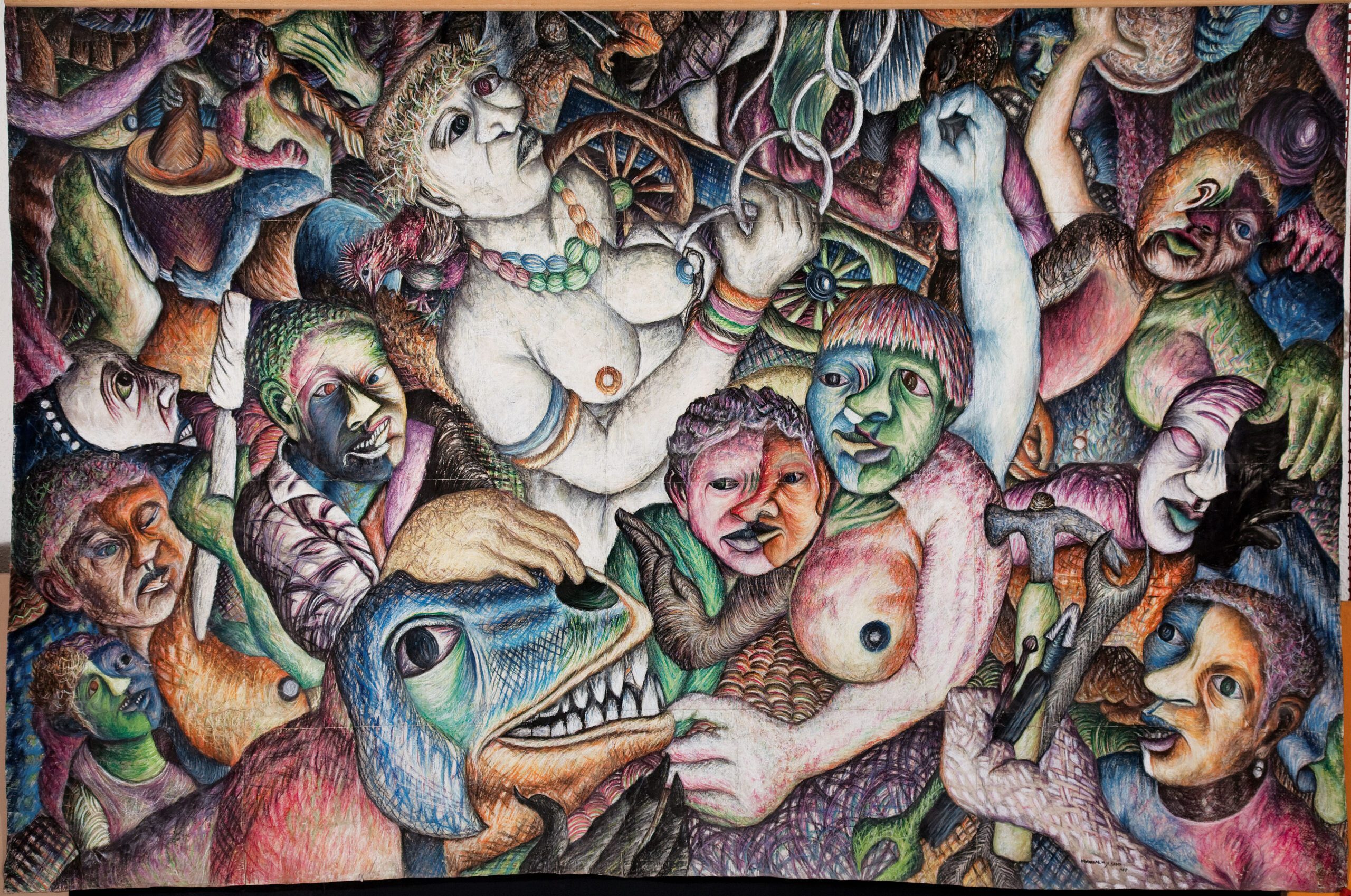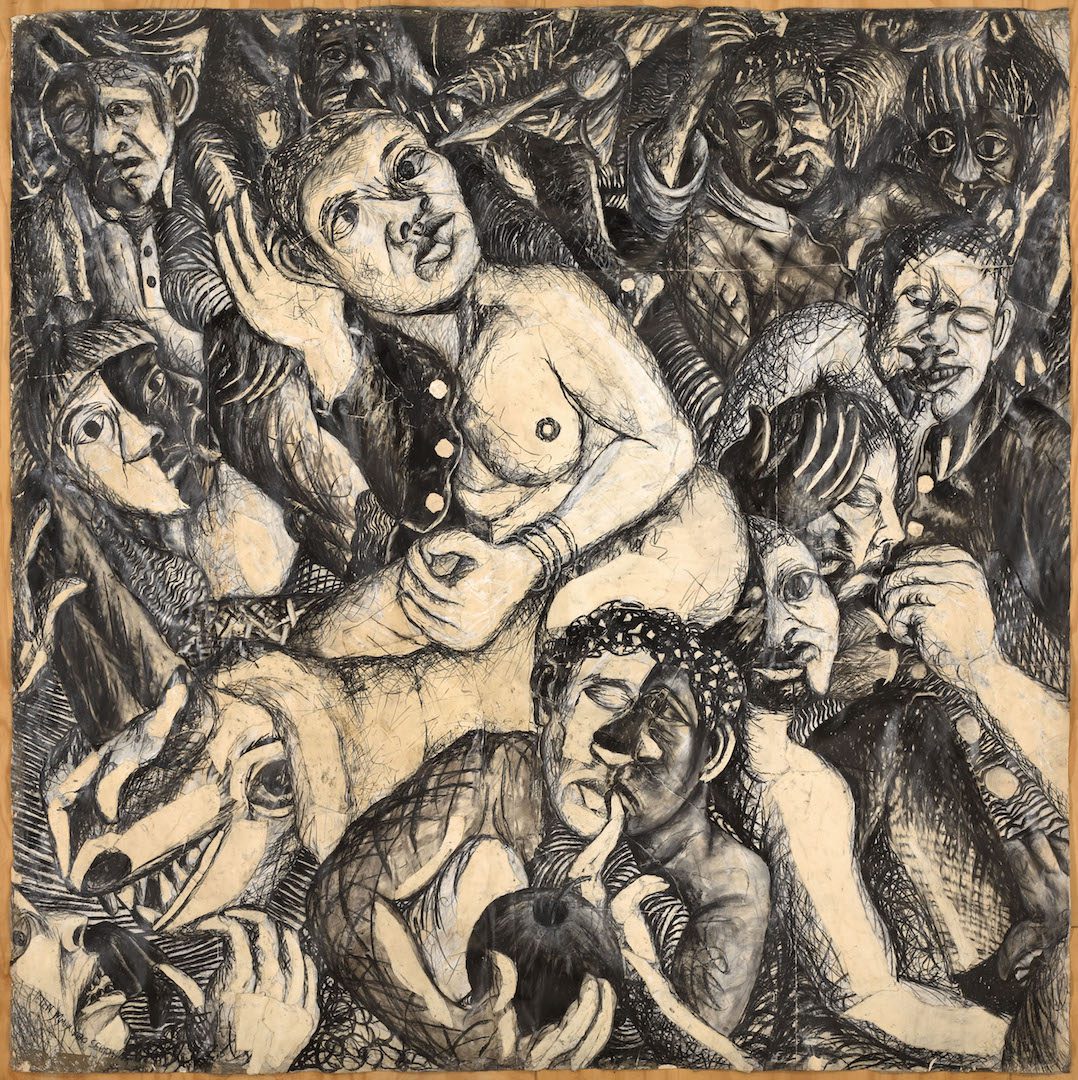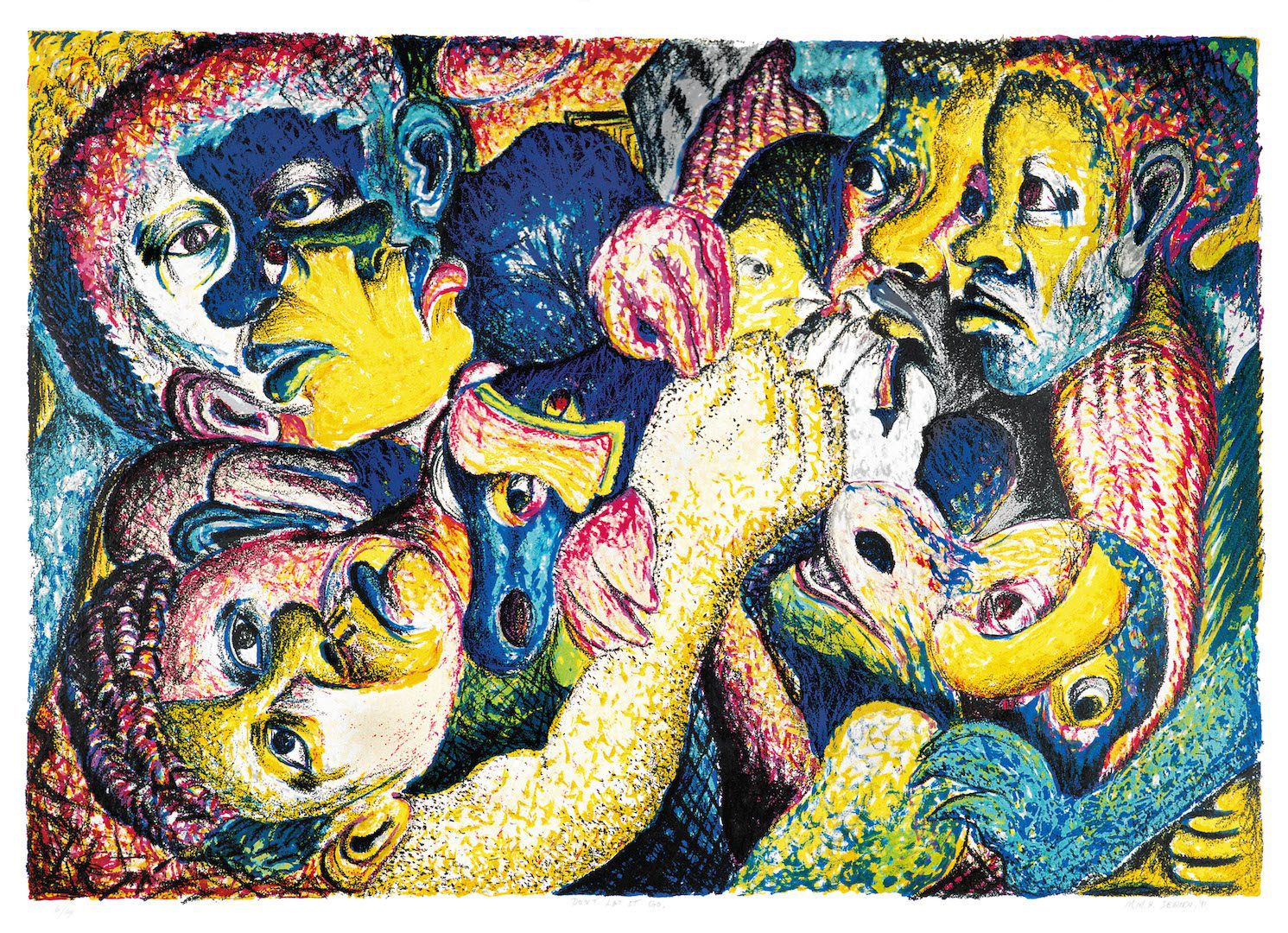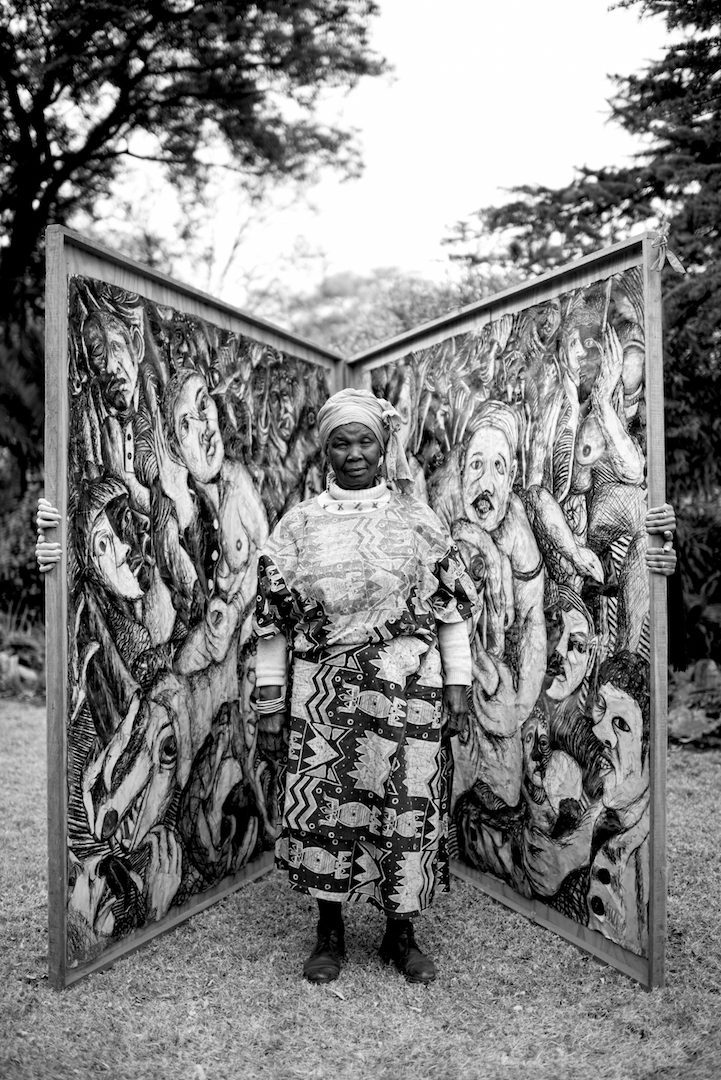Acclaimed South African painter Helen Sebidi, who is showing at the 32nd Bienal de São Paulo, chats about home, land, history and ancestral tears with Gabi Ngcobo, Luciane Ramos-Silva and Thiago de Paula Souza

Helen Sebidi. Mangwano Olshara Thipa Kabhaleng (The Child’s Mother Holds the Sharp next page Side of the Knife), 1988-1989. Acrylic on canvas. Collection: Iziko South African National Gallery. Photo: Helen Sebidi. Courtesy of the artist
Luciane Ramos-Silva: Could you introduce yourself, bringing in the idea of home as a place where we can be, a place we can belong, and home as your place of art?
Helen Sebidi: Home is my place of art. I believe that charity begins at home. Traditionally this was a moving home, not a home to own like we do now. You have to be natured in your home. I also need to communicate with other homes, that is my duty. Other homes means that you are building the human being inside, alone, and the being is held spiritually by those who help you to see the world. Those people will also say to you, “We don’t own this world, we are its messengers.” We have been given the task of a messenger to transform culture and to communicate. My grandmother used to say to me, “I am built inside you.” It is therefore my duty to move this world as well.
LRS: Thinking about land and country, tradition, community, could you elaborate on those spaces you came from? Because in Brazil we don’t have so much connection with the histories and realities of South Africa, so could you tell us about it?
HS: I would start with the land. Our people were working on the land in order to follow the path that the Creator had given them. Then the European community introduced pensions, but our people said: “We don’t want to be given money from those people. These people want to take our land that was given to us by the Creator to do work for Him.” They rejected the pension because they believed that what they had been born for is what they have to work for. So traditionally I would say, the seeds were planted by the Creator and when the reward comes, we have got it here in our hand, we worked for it. We must know our seed and that is the only way that we will save growing cultures, communicating cultures. Before that happens, we will suffer. Africa was the first continent that was built and made by God, by reality. The Creator knew what He was doing. I am proof of who I am and I still say, I will never ever join someone else’s culture without communicating. My grandmother died in 1981, she pointed at me with a big finger and told me, “You are not going to work for white people, your parents have been taken by white people, but you are not gonna be taken.” As I travel around, I take with me all the seeds she planted in me.

Helen Sebidi, Tears of Africa, 1987-1988. Mixed media, charcoal, pastel on paper. Photo: Helen Sebidi. Collection: the artist. Courtesy of the artist
Gabi Ngcobo: I would like to take a cue from your description of Africa and the complexities of Africa as a continent in order to speak about the work you will show at the 32nd São Paulo Biennale, Tears of Africa from 1989, which you created before the car accident you were involved in in August 1989…
HS: …even before my understanding of the continent. During the conflicts in the townships of Johannesburg, I happened to see death. I happened to have blood all over my clothes when a child was shot. I had gone away from the Johannesburg Art Foundation and moved to Alexandra (a township) to teach, and the same things happened there. I was shocked. The people who came from Europe brought their culture to our continent. They stopped those who came from the rural areas because they knew they would come and demolish the town. And when you went to the rural area as a township person, you used to be stopped and told not to come back.
GN: Stopped by whom?
HS: Stopped by the white people. We had to report at the police station to be allowed to sleep in the township, otherwise we were arrested. You would go for six months, then, when you came back you were caught and went to jail because you crossed the border against the law. It was a protective measure that was helping them to keep our people working for them. That is a kind of slavery that made our people much more severely dominated because they left their work and when they were supposed to pray they had to pray to white people, even today. So of course we made them richer and richer.
GN: What do you think about showing Tears of Africa in Brazil? What do you hope for the people seeing this work?
HS: The people who see this work could think of how to help our people to return to praying in the same way we learned at home. They could find their way back because their ancestors were shipped to Brazil as slaves, not knowing where they were going. So now they will have to get back to learning how they can pick up the seeds. Their freedom will come when they pick up the seeds.

Helen Sebidi, Don’t Let It Go, 1991. Silkscreen on paper. Photo: Helen Sebidi. Courtesy of the artist
GN: When you say they can find their way back, do you mean this symbolically, through your work?
HS: I think they will learn who they are and live who they are and be sure of who they are – in Brazil. Those tears of the ancestors will change, it will be love, it will not be tears anymore but it will be something that will help communication, and the chains of the tears will disappear. Because they will have their own seeds and they will know where they are going and what to do…
Thiago de Paula Souza: You will produce a new work for the Biennale, which will be shown together with Tears of Africa. I am interested in how you have been developing your work over the years; your skills, your techniques, your way of producing your art in the context of the new generations you have witnessed being born and growing. Could you also talk about the differences in generational spirit, especially because some younger people may think of themselves as the so-called “born frees”?
HS: I don’t think there is any such thing as a born free person. Because born free people don’t understand – that is why I have spoken about ownership – that we don’t own ourselves. We need to move around and see things properly, knowing that we don’t own anything. When you don’t go to the other side you don’t see what is there. It is like my work, I don’t know what I will be doing when I reach the studio in Salvador, Bahia. I will be surprised by what I bring back after visiting all the places I will be going to. My dreams are partly important for my production. But I also just start by playing and following what is coming from in here and from out there. In the end, that is where I am able to guide what I have been doing. It is spiritually awakening and I am quite happy be able to work that way.

Helen Sebidi, Life’s Work, 2012. Helen Sebidi’s home in Parktown, Johannesburg. Courtesy of the artist © 21 Icons
LRS: To get back to Tears of Africa, it evokes a sense of people seduced by the life of the city, right? I am thinking about your transition and your experience in Johannesburg and outside of South Africa. Could you talk about those bridges?
HS: There is a big gap between the rural areas and the city in South Africa. City life developed by stealing from the countryside, white people stole the skills of the rural population and claimed them as theirs. If there had not been apartheid in South Africa, the rural areas would have been well developed and the world would have understood that Africa has the best forests.
Gabi Ngcobo is one of the co-curators, 32nd Bienal de São Paulo. Artist, independent curator and educator, Ngcobo is a member of faculty at the Wits University School of Arts, in Johannesburg.
Luciane Ramos-Silva is an anthropologist, choreographer, and community arts organizer. A doctoral candidate in performing arts, she is a member of the editorial advisory board of the Magazine OMenelick 2°Ato.
Thiago de Paula Souza lives in São Paulo, where he works as an educator at the Afro-Brazilian Museum (Museu Afro Brazil). His current research concerns race relations, African and Afro-Brazilian art, and the depiction of art from Africa and the diaspora in the German-speaking context.
More Editorial